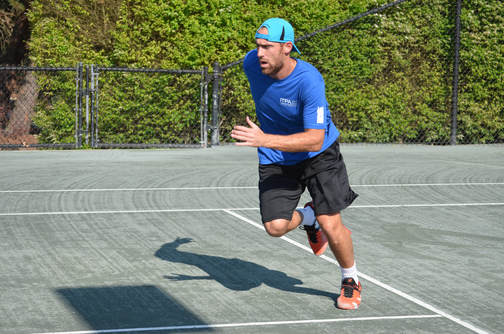It’s important to consider the open-skill nature of the sport of tennis, where each ball is hit at different locations on the court with varying degrees of spins and velocities. This requires a great degree of reactiveness, responding to stimuli and simultaneously providing an adequate amount of ground reaction force for first step quickness. The concept of developing relative lower-body strength (at loads of at least 80% of 1-RM) becomes paramount in recruiting the muscle fibers necessary for explosive movement around the court. Research by Hoope et al has found that teenage tennis players perform around 50-55 accelerations and 45-50 decelerations over the course a two-set match. The average explosive burst covers around 3 meters (Kovacs, 2006), and depends on the ability of the tendons to utilize the fast-stretch shortening cycle. Tennis trainers should understand this demand of the sport, using resistance training to develop both eccentric and concentric strength in addition to the reactive strength required provide rapid force development.
It has been argued by top tennis coaches that the sport is won not necessarily through hitting winners but rather inducing forced errors; variables like spin, depth, power, height, and taking time away from the opponent can all be used to force players out of position, where ideal movement application and power production allow a player to remain in the point. The nervous and muscular systems must be able to provide continual activity, requiring both the work capacity AND its ability to endure the activity. That being said, any improvements in the anaerobic and aerobic capacity would be beneficial to a tennis athlete and allow them the best opportunity to keep the point alive. A recent 2018 study by Isha et al. has demonstrated that SAQ (speed, agility, and quickness) training can significantly improve junior performance for both T-test (movement) scores and VO2-max (aerobic capacity) compared to a control group. The experimental group, who received SAQ training 3 times a week over the course of a month, performed drills that consisted of resisted runs and upper-lower body plyometrics at similar work to rest intervals seen in tennis points (about 20 to 30 seconds of work with 1 to 2 minute breaks). The authors suggest that this tennis-specific overloading of the proprioceptive organs leads to positive adaptations and should lead to improved movement capabilities on the court.
The necessity of effective movement training cannot be overemphasized, as even a split- second difference in multiplanar displacement can result in being in an offensive position as opposed to a defensive one. Gil Reyes, the legendary trainer of Andre Agassi, has said that “weak legs obey, while strong legs command,” with the lower body commanding both the strength and endurance to compete in the sport. In end, it could be what separates the “good” from the “great.”
Isha, Garg, and Khurana Sunal. Effective Conditioning Program for Junior Tennis Players. Journal of Physical Fitness, Medicine, and Treatment in Sports , 21 May 2018, juniperpublishers.com/jpfmts/pdf/JPFMTS.MS.ID.555629.pdf.
https://www.ncbi.nlm.nih.gov/pmc/articles/PMC2653871/





 RSS Feed
RSS Feed
